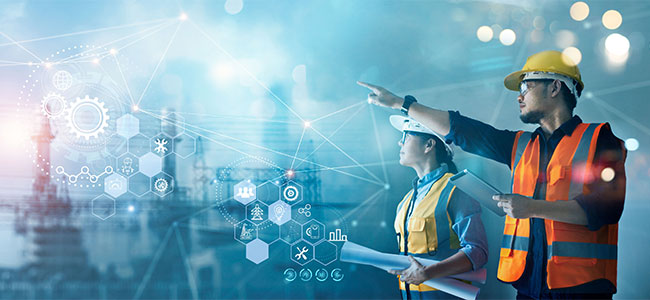
Integrating AI in Maintenance Protocols for Safer Industrial Environments
AI is revolutionizing how industries approach safety, turning maintenance routines from reactive to proactive.
- By Eric Whitley
- Jan 22, 2024
What makes an industrial environment safe? Safe environments minimize risk and prioritize the well-being of every worker. And here's where AI comes in. AI is revolutionizing how industries approach safety, turning maintenance routines from reactive to proactive. Now let’s explore the ways AI is being woven into the fabric of industrial safety, ensuring a safer today and tomorrow.
Streamline Maintenance Processes with AI
Integrating AI into industrial maintenance is essential for modern industries. This involves using AI algorithms to analyze equipment data thoroughly, which helps in optimizing maintenance schedules and tasks, making processes more efficient.
The main advantage is a significant reduction in human error, making maintenance processes smarter and not just faster. AI enables health and safety managers to predict and prevent potential issues, ensuring a safer workplace.
For instance, in a manufacturing plant with continuous machinery operation, traditional maintenance relies on scheduled checkups or reacting to breakdowns. However, AI can analyze vibration data and predict problems—like a bearing failure—well in advance.
The proactive approach allows maintenance to be conducted timely without disrupting production, leading to safer, more reliable and more efficient operations. This AI-driven method represents a shift from reactive to proactive maintenance, prioritizing safety and the well-being of the workforce.
Predict and Prevent Safety Hazards with AI
The role of AI in predictive maintenance is crucial, as it extends beyond mere data monitoring to provide predictive insights. These insights are key to foreseeing equipment failures well before they escalate into safety hazards.
This proactive approach significantly reduces the likelihood of accidents and equipment damage, representing a major shift in industrial safety management. It effectively transforms the unpredictability of equipment failure into a manageable and foreseeable event.
Consider a chemical plant, where even minor equipment malfunctions could result in severe disasters. In such a dangerous environment, an AI system serves as a vigilant guardian, constantly analyzing equipment data for any indication of potential issues.
Imagine this system detecting subtle, unusual temperature fluctuations in a reactor, changes that might typically go unnoticed by human operators. The AI's warning facilitates an immediate inspection, which can effectively prevent what could otherwise have been a devastating explosion.
Enhance Worker Safety with AI Tools
Integrating AI into worker safety strategies is a significant step forward in industrial safety management. This integration involves equipping workers with AI-enhanced tools, such as smart wearables, which act as crucial safety lifelines in hazardous situations. These devices continuously monitor environmental conditions and the wearer's vital signs, providing instant risk assessments and responses.
For example, in a warehouse environment, workers can wear AI-powered smart helmets that actively scan the surroundings for potential hazards, like gas leaks or sudden temperature changes. If a danger is detected, the helmet immediately alerts the wearer, enabling quick reactions, such as evacuating the area.
This application of technology transforms safety equipment from a passive form of protection to an active form of guardianship. Health and safety managers, charged with ensuring safe working environments, can now be confident that their workers are not only well-protected but also proactively equipped to deal with potential hazards.
Mitigate Risks with Connected Worker Technology
Using connected worker technology greatly improves worker safety. Workers can use tools like AI-powered smart glasses or wearables that give instant warnings and visual signals about dangers. This helps them make fast, smart choices to avoid accidents.
In a connected manufacturing environment, workers wearing AI smart glasses get a better understanding of their surroundings. These glasses show important safety details right in their view, like pointing out risky areas in the plant or places with dangerous materials. This visual help is key to keeping workers alert and ready to handle possible dangers.
This use of technology, with AI, is changing the way safety is managed. It makes safety a natural part of workers' daily jobs. For those in charge of health and safety, this technology leads to a more aware and proactive workforce.
Emphasize Safety with Smart Manufacturing
Smart manufacturing uses AI for maintenance and safety, changing how industries work. It monitors and analyzes equipment in real time, predicts problems before they happen, and increases safety and efficiency.
The advantages go well beyond safety; smart manufacturing improves overall operations. It finds and fixes inefficiencies, making processes better. It always collects and analyzes data, adjusting work to be more efficient.
Take a car manufacturing plant, for example. In such a high-stakes environment, mechanical failures can be costly and dangerous.
With AI, the plant takes a proactive approach to risks. The AI system constantly monitors the production line, analyzing everything from machine performance to workflow. It actively seeks improvement areas and adjusts processes in real time, significantly lowering the risk of mechanical failures. This creates a safer workspace and ensures smoother, more efficient operations.
This example illustrates how smart manufacturing combines safety and efficiency, helping both workers and the business.
The Road Ahead for AI-Driven Safety in the Industrial Sector
Integrating AI into maintenance protocols for safer industrial environments isn't without its challenges. These range from technical hurdles, like data accuracy, to broader issues like cost and workforce adoption.
However, the future looks promising. AI is expected to become more sophisticated, offering more detailed insights and better predictive capabilities. This evolution could lead to even safer, more efficient industrial environments.
Balancing these challenges and opportunities, consider how evolving AI technologies will redefine industrial safety standards. Let’s think about the necessary steps to smoothly integrate these advancements while addressing the associated challenges.